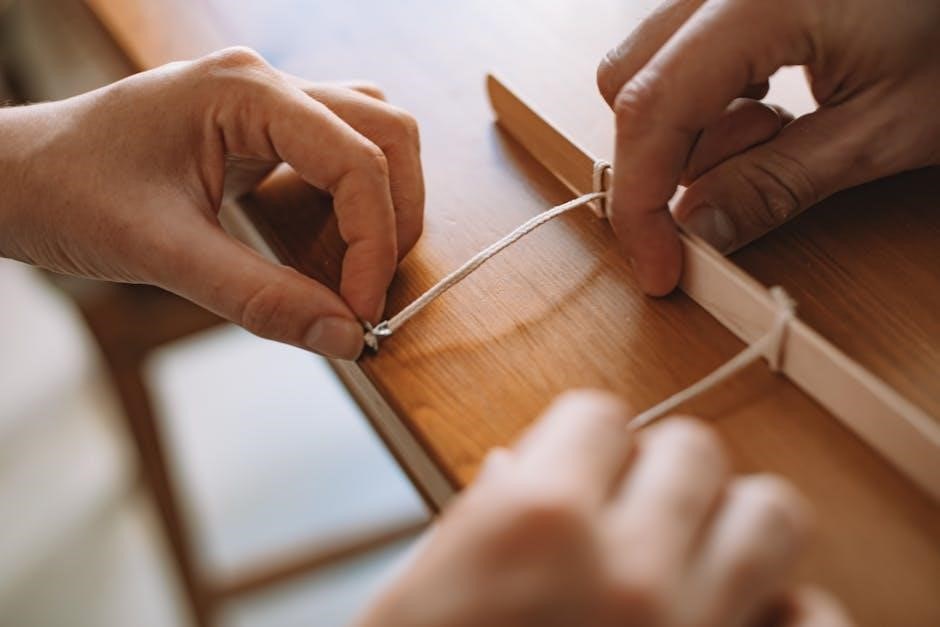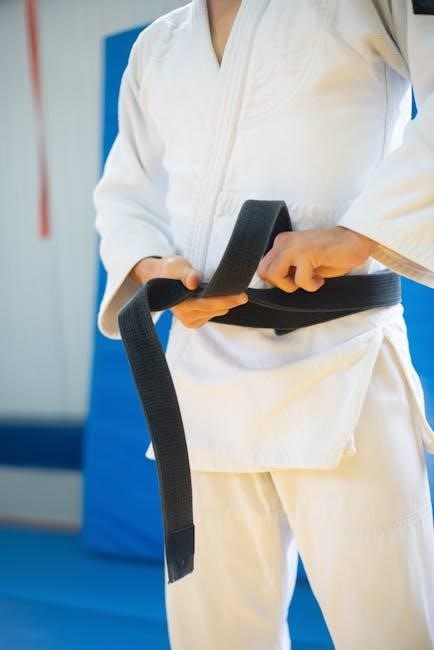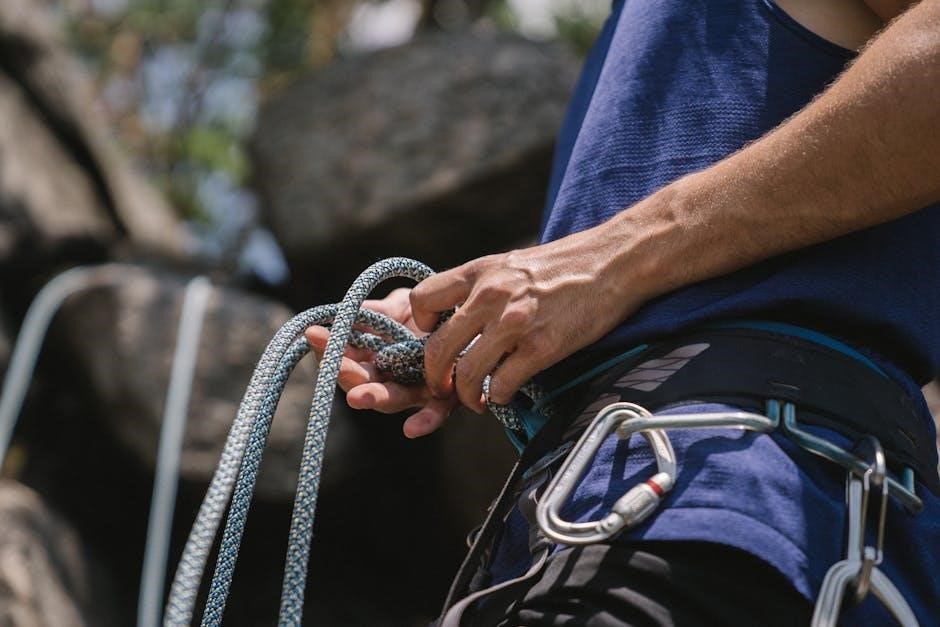A printable knot tying guide PDF offers a clear, concise resource for mastering essential knots. It includes step-by-step visuals and instructions for popular knots like the bowline and square knot, making it easy to practice and reference anytime, anywhere.
Importance of Knot Tying Skills
Knot tying is an essential skill with wide-ranging applications, from outdoor adventures to emergency situations. It enhances preparedness, confidence, and self-reliance. Whether camping, sailing, or rescuing, mastering knots ensures safety and efficiency. A well-tied knot can secure loads, create reliable loops, or even save lives. Its versatility makes it a valuable tool in various professions and hobbies. While modern tools exist, traditional knot tying remains indispensable for its simplicity and effectiveness. Developing this skill fosters problem-solving and hand-eye coordination, making it a lifelong asset. A printable guide simplifies learning, providing clear visuals and step-by-step instructions to build proficiency in tying knots effectively.
Purpose of a Printable Guide
A printable knot tying guide serves as a practical tool for learning and mastering various knots. Its purpose is to provide clear, step-by-step instructions and visuals, enabling users to practice efficiently. The guide is designed to be portable, allowing easy access during outdoor activities or workshops. It organizes knots by complexity and application, helping users progress from basic to advanced techniques. High-quality visuals and concise descriptions make learning intuitive. The guide also caters to both professionals and hobbyists, ensuring versatility. By offering a structured approach, it simplifies the process of acquiring essential knot tying skills, making it an invaluable resource for anyone seeking to improve their proficiency.

Basic Knot Tying Techniques
Mastering basic knots like the Overhand, Square, Half Hitch, and Clove Hitch forms the foundation for more complex knots. These essential techniques are clearly illustrated in the guide, making learning straightforward and accessible for all skill levels.
Overhand Knot
The Overhand Knot is one of the simplest and most essential knots to learn. It forms the foundation for many other knots and is commonly used in various applications, from crafting to securing lines. To tie an Overhand Knot, create a loop in the rope, pass the working end through it, and pull tight. This knot is quick to tie and reliable for lightweight tasks. It’s often used as a stopper knot or to prevent fraying at the end of a rope. While it may slip under heavy tension, it’s an excellent starting point for beginners and a versatile tool for everyday use.
Square Knot (Reef Knot)
The Square Knot, also known as the Reef Knot, is a simple and reliable knot for joining two ends of a rope. It is widely used in camping, sailing, and first aid due to its ease of tying and strength. To create a Square Knot, overlap the two ends of the rope, wrap one end over the other, then tuck it under and pull tight. This knot works best with ropes of similar thickness and holds securely under tension. However, it can slip with nylon or slippery materials. Despite this, it remains a fundamental knot for everyday and outdoor activities, providing a quick and effective solution for securing lines.
Half Hitch
The Half Hitch is a simple yet essential knot used to secure a rope to an object. It is commonly employed in camping, sailing, and outdoor activities. To tie a Half Hitch, wrap the rope around the object, pass the end under the standing part, and pull tight. This knot is often used in combination with others, such as the Clove Hitch, to create a more secure fastening. Its simplicity makes it a versatile choice for temporary fixes or adjusting tension. While it may not be suitable for heavy loads on its own, it is a reliable and quick solution for everyday use.
Clove Hitch
The Clove Hitch is a reliable and adjustable knot ideal for securing ropes to poles or posts. It is widely used in camping, sailing, and outdoor activities due to its versatility. To tie a Clove Hitch, wrap the rope around the object, crossing over itself to form two loops. Pass the end under the standing part and pull tight to secure. This knot is easy to adjust and can be tightened or loosened as needed. While it may slip under heavy loads, it can be reinforced with additional hitches for greater security. Its simplicity and adaptability make it a essential skill for anyone working with ropes.

Common Knots for Everyday Use
Discover essential knots for daily tasks, such as the Bowline, Sheet Bend, and Taut-Line Hitch. These versatile knots are perfect for camping, securing loads, and household repairs, ensuring practicality and reliability.
Bowline Knot
The Bowline Knot is a fundamental knot used to create a fixed loop at the end of a rope. It is highly reliable and easy to untie, making it ideal for sailing, rescue operations, and outdoor activities. To tie a Bowline Knot, form a small loop in the rope, pass the working end through it, then wrap it around the standing part and back through the loop. This knot is essential for securing loads, hoisting, and creating a secure point for anchoring. Practice the “rabbit hole” method for a quick and consistent tie. Its versatility and strength make it a must-know for any knot tying enthusiast.
Sheet Bend
The Sheet Bend is a simple and effective knot used to join two ropes together, even if they differ in size or material. It is particularly useful for situations requiring a secure connection between ropes of varying thickness. To tie a Sheet Bend, overlap the ends of the two ropes, form a loop with one rope, and pass the other rope through it. Tuck the end under itself and pull tight to secure. This knot is reliable for camping, sailing, and emergency repairs. Its ease of use and versatility make it a key knot in any knot-tying guide, ensuring quick and dependable connections.
Taut-Line Hitch
The Taut-Line Hitch is an adjustable and secure knot ideal for temporary fastening, such as tightening tent lines or securing loads. To tie it, wrap the rope around a post, pass it through a loop, and create a second loop to pull tight. This knot is highly versatile, allowing for easy adjustments even after securing. Its simplicity and reliability make it a favorite for camping and outdoor activities. The Taut-Line Hitch is included in many printable guides due to its practicality and ease of learning, ensuring quick and dependable use in various situations requiring secure and adjustable fastening.
Timber Hitch
The Timber Hitch is a robust and reliable knot commonly used for securing and dragging heavy objects like logs. It is simple to tie and untie, making it ideal for outdoor tasks. To create a Timber Hitch, wrap the rope around the object, pass the end through a loop, and secure it with a half-hitch. This knot holds tightly under tension but releases easily when loosened. Its practicality and ease of use make it a staple in many printable guides, ensuring quick and efficient application in various scenarios requiring sturdy fastening and transportation of heavy materials.

Advanced Knot Tying
Advanced knot tying involves complex techniques for specialized applications. Knots like the Prusik, Alpine Butterfly, and Figure Eight are featured, offering secure solutions for climbing, rescue, and heavy-duty tasks. These knots require precision and practice but provide unparalleled reliability in challenging situations, making them essential for experienced users seeking to expand their skills.
Prusik Knot
The Prusik Knot is a critical component in advanced knot tying, essential for climbing and rescue operations. It creates a sliding hitch that grips a rope when pulled, allowing for secure ascending or descending. This knot is particularly useful in situations requiring temporary anchors or hoisting. The Prusik Knot is highly reliable when tied correctly, making it a cornerstone of search and rescue training. A printable guide provides clear, step-by-step visuals to master this technique, ensuring safety and precision. With proper practice, the Prusik Knot becomes an indispensable tool for climbers and rescue professionals, offering unmatched security in high-stakes environments. Its versatility and strength make it a must-learn for anyone serious about knot tying.
Alpine Butterfly Knot
The Alpine Butterfly Knot is a reliable and versatile loop knot commonly used in climbing and mountaineering. It is known for its ease of tying, strength, and resistance to jamming, making it ideal for connecting ropes or creating a secure anchor point. Unlike other knots, the Alpine Butterfly Knot can be tied in the middle of a rope, allowing for efficient use in challenging situations. A printable guide provides detailed visuals and step-by-step instructions, enabling enthusiasts and professionals to master this essential knot. Whether for rescue operations or outdoor adventures, the Alpine Butterfly Knot is a must-know for anyone seeking reliability and precision in their knot-tying skills.
Figure Eight Knot
The Figure Eight Knot, also known as the Flemish Knot, is a essential stopper knot widely used in rock climbing, sailing, and rescue operations. Its primary purpose is to prevent a rope from running out of a pulley or block and to create a secure, fixed loop at the end of a line. This knot is valued for its simplicity, reliability, and ease of inspection. A printable guide often includes step-by-step visuals and instructions, making it easier to master the Figure Eight Knot. It is particularly useful in situations requiring a strong, durable knot that can withstand heavy loads, ensuring safety and efficiency in critical applications.
Rolling Hitch
The Rolling Hitch is a versatile and secure knot used to fasten a rope to a post, spar, or another rope. It is particularly effective in situations where the rope may be subject to movement or tension, such as in sailing or climbing. The Rolling Hitch is highly adjustable and can be easily released even after bearing a heavy load. It is commonly used in nautical and rescue operations due to its reliability and ease of application. A printable guide provides clear, step-by-step instructions and visuals, making it easier to master the Rolling Hitch. This knot is essential for anyone needing a secure, adaptable fastening solution.

Safety Guidelines for Knot Tying
Always inspect ropes for wear and follow proper tying techniques to ensure reliability. Use a printable guide to learn safe methods and avoid potential hazards in all applications.
Choosing the Right Rope
Selecting the appropriate rope is crucial for effective knot tying. Consider the material, thickness, and flexibility based on the task. Nylon and polyester ropes are durable and resistant to moisture, making them ideal for outdoor use. Natural fibers like cotton or hemp are better for crafts or decorative purposes. Ensure the rope’s diameter matches the knot’s requirements, as thicker ropes can be harder to manipulate. Always inspect the rope for frays, cuts, or signs of wear before use. A high-quality rope will hold knots securely and reduce the risk of failure. Refer to your printable guide for recommendations on the best ropes for specific knots.
Avoiding Common Mistakes
When tying knots, common mistakes include improper looping, insufficient tension, or incorrect wrapping. Ensure the rope is not twisted and that loops are formed accurately. Avoid crossing strands in the wrong order, as this can weaken the knot. Inspect each knot for symmetry and tightness before use. Overloading knots or using the wrong type for the task can lead to failure. Practice tying knots slowly and methodically, especially in critical situations; Refer to your printable guide for step-by-step visuals to avoid errors. Regular practice helps develop muscle memory and reduces the likelihood of mistakes. Always test knots before relying on them.

Inspecting Knots Before Use
Inspecting knots before use is crucial for ensuring safety and reliability. Always check for proper tension, symmetry, and that there are no twists or tangles. Verify that the knot sits correctly and holds its intended shape. Look for any signs of wear, fraying, or damage to the rope. Ensure all strands are evenly tightened and that the knot is secure. A well-inspected knot is more likely to perform reliably in critical situations. Regular inspection helps catch potential issues early, preventing failures. Use your printable guide to cross-reference proper knot formation. This step is essential for both beginners and experienced individuals to maintain consistency and safety in knot tying.

Applications of Knot Tying
Knot tying is essential for camping, climbing, sailing, and rescue operations. It helps secure loads, create reliable connections, and ensure safety in various outdoor and emergency situations. The printable guide simplifies learning these critical skills for diverse applications.
Camping and Outdoor Activities
Knot tying is indispensable for camping and outdoor adventures, ensuring secure tent setups, shelter construction, and gear safety. Techniques like the taut-line hitch and bowline knot are crucial for campers, enabling them to create reliable connections and manage ropes effectively. The printable guide offers step-by-step visuals, making it easier to master these essential skills in the field. Whether securing a tent, hoisting gear, or creating a makeshift pulley, proper knot tying enhances safety and efficiency. For outdoor enthusiasts, this guide becomes a vital tool, ensuring preparedness and confidence in various wilderness scenarios. It’s a must-have resource for anyone venturing into nature.
Climbing and Mountaineering
Knot tying is a cornerstone of climbing and mountaineering, ensuring safety and reliability in critical situations. The printable guide provides detailed instructions for essential climbing knots, such as the bowline, figure-eight, and alpine butterfly. These knots are vital for securing ropes, creating anchors, and managing load distribution. The guide’s visual aids and step-by-step instructions make it easier to master these techniques, even for beginners. Whether rappelling, belaying, or setting up anchors, proper knot tying is non-negotiable for safety. This resource is indispensable for climbers, offering a portable and accessible way to refine their skills and prepare for expeditions. It ensures climbers can trust their setups in high-stakes environments.
Sailing and Boating
Knot tying is essential for sailing and boating, ensuring safety and efficiency on the water. The printable guide highlights key maritime knots like the bowline, cleat hitch, and clove hitch, which are crucial for securing sails, docking, and managing lines. Clear step-by-step instructions and visuals help sailors master these knots quickly. Whether anchoring, mooring, or hoisting sails, proper knot tying prevents accidents and ensures smooth operations. This resource is a must-have for sailors and boaters, providing a portable reference to practice and refine their skills. It helps build confidence and ensures reliability in critical maritime situations, making it an invaluable tool for water enthusiasts of all levels.
Search and Rescue Operations
Knot tying is critical in search and rescue operations, where reliability and strength are paramount. The printable guide features essential knots like the bowline and figure eight, used for securing individuals or creating stable loops. Clear visuals and step-by-step instructions ensure rescuers can quickly master these knots, even under pressure. The guide also covers the Prusik knot, ideal for ascending ropes in rescue scenarios. Proper knot tying enhances safety, efficiency, and effectiveness in critical situations, making the guide an indispensable resource for SAR teams. It empowers rescuers to perform confidently, knowing their knots will hold securely, potentially saving lives in emergencies.

Tips for Mastering Knot Tying

Tips for Mastering Knot Tying
Consistent practice and visual aids are key to mastering knots. Use the printable guide for step-by-step instructions and focus on understanding rope behavior to tie knots efficiently and effectively.
Practice and Repetition
Consistent practice is the cornerstone of mastering knot tying. Regularly revisiting each knot in the printable guide ensures familiarity and builds confidence. Start with simple knots like the overhand and square knots, gradually progressing to more complex ones. Repetition helps develop muscle memory, making tying knots second nature. Use the guide’s step-by-step visuals to refine your technique and avoid mistakes. Track your progress by marking completed knots, which motivates you to continue. Dedicate short daily sessions to practice, as even a few minutes can significantly improve your skills over time. This disciplined approach will transform you into a proficient knot-tier.
Using Visual Aids
Visual aids in the printable knot tying guide PDF are invaluable for mastering knots. High-quality images and diagrams break down each step, making complex knots easier to understand. These visuals clarify hand positions, loops, and wraps, reducing confusion. Color-coded illustrations highlight key steps, ensuring clarity. For visual learners, these aids are particularly effective, as they provide a clear reference point. The guide’s step-by-step visuals allow learners to follow along at their own pace, pausing to practice each stage. This method enhances retention and reduces errors. By combining text with images, the guide caters to diverse learning styles, making knot tying accessible to everyone. Regular use of these visuals accelerates skill mastery.
Understanding Rope Characteristics
Understanding rope characteristics is essential for effective knot tying. Different ropes vary in material, thickness, and flexibility, impacting their performance. Nylon and polyester ropes are durable and resistant to water, while natural fibers like cotton are softer but less durable. The diameter and texture of the rope affect knot security, with thicker ropes being harder to manipulate but providing greater strength. Familiarizing yourself with these traits helps in selecting the right rope for specific tasks. The printable knot tying guide PDF provides detailed insights into these factors, ensuring you choose the optimal rope for your needs and tying situation.
How to Use the Printable Guide
Access the printable knot tying guide PDF by downloading it from a reliable source. Review the step-by-step visuals and clear instructions. Practice each knot methodically, starting with basic ties like the square knot and progressing to more complex ones. Use the guide as a handy reference for quick tips and troubleshooting. Regular practice with the guide will enhance your knot-tying skills and confidence in various applications, from camping to sailing. The guide is designed to be user-friendly, ensuring you master every knot efficiently.
Downloading and Printing

Downloading and printing the knot tying guide PDF is straightforward. Ensure you have a stable internet connection and a compatible device. Locate the download link on a trusted website and save the file to your device. Open the PDF using a viewer like Adobe Acrobat. Print the guide on standard paper sizes like A4 or Letter for clarity. Adjust printer settings to ensure high-quality images and text. Once printed, organize the pages in a binder or booklet for easy reference. The guide’s visual instructions and step-by-step format make it ideal for learners of all skill levels. Keep it handy for quick access during practice sessions.
Organizing the Guide
Organizing the guide ensures easy access and effective learning. Start by printing all pages and reviewing the content. Use a three-ring binder or folder to keep the guide tidy. Separate the sections with tabs or dividers, such as basic knots, advanced knots, and safety tips. Laminate the pages for durability, especially if you plan to use the guide outdoors. Consider adding a table of contents or index for quick navigation. Group similar knots together, like loops, hitches, and bends, for focused practice sessions. Store the guide in an accessible location, like a workshop or camping gear box, to reference it whenever needed. Regularly review and update the guide to reflect new skills or techniques.
Following Step-by-Step Instructions
Following step-by-step instructions in the printable guide ensures mastery of each knot. Begin by carefully reading the description and understanding the purpose of the knot. Look at the visual diagrams to grasp the sequence of loops and wraps. Start with simple knots, such as the square knot or half hitch, and gradually progress to more complex ones like the bowline or figure eight. Practice each step slowly, checking your work as you go. Repeat the process until the knot becomes second nature. Pay attention to details like tension and symmetry, as these are critical for reliability. Regular practice with the guide will build confidence and skill in knot tying. Stay patient and persistent to achieve perfection.
A printable knot tying guide PDF is an invaluable resource for mastering essential knots. Regular practice and referencing the guide will lead to skill mastery and versatility in various applications, ensuring confidence in tying knots for any situation.
Final Thoughts on Knot Tying
Knot tying is a timeless skill that offers practical applications across various industries and everyday life. The printable knot tying guide PDF serves as an excellent companion for learners, providing clear visuals and step-by-step instructions for mastering essential knots like the bowline and square knot. By dedicating time to practice and referencing the guide, users can build confidence in their ability to tie knots effectively. Whether for camping, sailing, or emergencies, this guide ensures that the knowledge of knot tying is accessible and easy to apply, making it an indispensable resource for anyone seeking to improve their skills.
Encouragement to Keep Practicing
Consistent practice is key to mastering knot tying, and the printable knot tying guide PDF is an excellent tool to support your journey. Embrace challenges and celebrate small victories, as each knot learned brings you closer to proficiency. Regular repetition strengthens muscle memory and builds confidence. Don’t be discouraged by initial difficulties—persistence pays off. Use the guide’s clear instructions and visuals to refine your technique. Over time, you’ll find tying knots becomes second nature, empowering you to tackle tasks with ease and precision. Keep practicing, and soon you’ll be tying knots like a pro, ready for any situation life presents.
